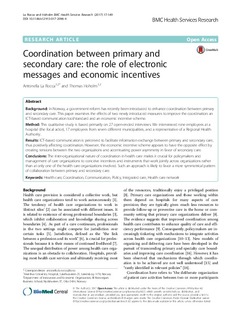Coordination between primary and secondary care: The role of electronic messages and economic incentives
Journal article, Peer reviewed
Permanent lenke
http://hdl.handle.net/11250/2434283Utgivelsesdato
2017Metadata
Vis full innførselSamlinger
- Scientific articles [2181]
Sammendrag
Background
In Norway, a government reform has recently been introduced to enhance coordination between primary and secondary care. This paper examines the effects of two newly introduced measures to improve the coordination: an ICT-based communication tool/standard and an economic incentive scheme.
Method
This qualitative study is based primarily on 27 open-ended interviews. We interviewed nine employees at a hospital (the focal actor), 17 employees from seven different municipalities, and a representative of a Regional Health Authority.
Results
ICT-based communication is perceived to facilitate information exchange between primary and secondary care, thus positively affecting coordination. However, the economic incentive scheme appears to have the opposite effect by creating tensions between the two organizations and accentuating power asymmetry in favor of secondary care.
Conclusions
The inter-organizational nature of coordination in health care makes it crucial for policymakers and management of care organizations to conceive incentives and instruments that work jointly across organizations rather than at only one of the health care organizations involved. Such an approach is likely to favor a more symmetrical pattern of collaboration between primary and secondary care.
Beskrivelse
This is an Open Access journal available from http://www.biomedcentral.com/
